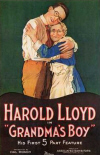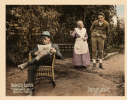|
| |
|
|
GRANDMA'S BOY |
 |
|
Pathé,
1922. Directed by Fred Newmeyer. Camera: Walter Lundin.
With Harold Lloyd, Mildred Davis, Anna Townsend, Charles Stevenson, Noah
Young, Dick Sutherland. |
|
  The setting is Blossom Bend, and we are introduced to Sonny, a meek
young man, at 19, "the boldest thing he ever did was sing out loud in
church." Sonny and his girl, Mildred, are making ice cream as a
surprise for her Ma. The bully moves in, intimidates Sonny, and
finally throws our Boy down a well. Sonny's "Never Shrink Brand"
suit, he learns, does not live up to its name: he walks home (
"mostly uphill, and no shade" ) with shirt cuffs and socks boldly
showing. Granny believes in Sonny, even if he does not. She
encourages him to throw the town tramp, The Rolling Stone, out of their
yard, but Sonny can't do it—Granny does. The setting is Blossom Bend, and we are introduced to Sonny, a meek
young man, at 19, "the boldest thing he ever did was sing out loud in
church." Sonny and his girl, Mildred, are making ice cream as a
surprise for her Ma. The bully moves in, intimidates Sonny, and
finally throws our Boy down a well. Sonny's "Never Shrink Brand"
suit, he learns, does not live up to its name: he walks home (
"mostly uphill, and no shade" ) with shirt cuffs and socks boldly
showing. Granny believes in Sonny, even if he does not. She
encourages him to throw the town tramp, The Rolling Stone, out of their
yard, but Sonny can't do it—Granny does.
That night, Mildred is hosting a party at her house, and Sonny (having
ruined his only suit) must wear his Granddaddy's outfit—he arrives at
her house "dressed strictly up to date—for the Spring of 1862."
Upon finding mothballs in his suit, he sneaks them into a candy box:
both Sonny and the bully wind up eating them.
Later that evening, a posse arrives at the house, announcing a search
for the tramp, who is wreaking havoc in town. Sonny unwillingly
becomes a member of the posse, but cowardice chases him home, and under
his sheets. Granny seizes the opportunity to tell Sonny a Civil
War story about his Granddaddy, who was also a coward...until he was
presented with a magic talisman, the Charm of Zuni, which gave him
courage. Granny just happened to have that very charm, and gave it
to Sonny.
Armed with a new-found courage, Sonny single-handedly captures the
tramp, and wins the admiration of the town. The only thing left to
do, with this courage of a lion, is to whip the bully. After he
gives the bully his comeuppance, Granny reveals that the charm was
nothing more than an umbrella handle: "There was no charm, Sonny;
it was all you. Granny knew her real boy better than he knew
himself." After this revelation, Sonny thought of just one more
thing to do: propose to Mildred. At first he thought he
needed the charm to stand up to her, but then threw it away, heeding his
Granny's words. Sans talisman, he proposed to his coquette: "Do
you love me? " Yes. "WILL YOU MARRY ME?" Yes.
"RIGHT NOW?" Yes. Sonny carries her off to a wonderful new life.
 %20-%20Harold%20Lloyd_small.jpg) Notes Notes
The reviews for this film
stand as a testament to its importance in its day. The New York
Morning Telegraph reviewed the film on September 10, 1922: "...A
monument ought to be erected to the man who put the Lloyd in celluloid."
The Moving Picture World,
on August 12, 1922:
"...The best picture Harold Lloyd ever made. The comedian's
first fling in the five-reel comedy field is a tremendous success."
Variety, from June 16, 1922: "It is a knockout, clean at
all times, and composed of truly funny situations. It is Harold
Lloyd's best."
This picture had two working titles:
The White Feather and He Who
Hesitates. Said Lloyd, in a January 1959 interview: "We
started it as a two-reeler, but it had a strength to it that we just
couldn't keep it at two reels...it developed into a five-reeler, which
was really our first true feature picture." (The word " true " is
key here, for, in those days, anything four reels or more in length was
considered a feature.) The film cost $86,012.38 to shoot, and
grossed $975,623.
Diana Serra Cary was a child actress in the silent film era, known as
Baby Peggy to millions of fans. According to her autobiographical
hook Whatever Happened to Baby Peggy?, in
1922, the Baby Peggy film, Grandma's Girl, a satire of Lloyd ' s
Grandma's Boy, was canceled after she got pneumonia, then the
director had a breakdown, and finally there was a fire at the studio.
From the Roach production logs: "Mr.
Lloyd left for New York on Monday, December 2, but the Lloyd staff is
held intact except Jean Havez. Those people not otherwise engaged
will be charged against the Lloyd picture for this week as they are
doing what the condition of the weather will allow them to do to
continue with the picture." Roach, Lloyd, and Mildred Davis
arrived back from New York on January 24, 1922, a Tuesday, and was back
at work on Thursday, January 26. Exteriors and story work were
done while he was gone. And, Harold was out sick from February 20
to 26. Most of the film was shot at Hal Roach Studios, Culver
City, CA.
Grandma 's Boy was the only comedy
named to the list of Top Ten Pictures of 1922 in Film Year Book
(it was number two). In addition, it was among the Top 40 Best
Pictures of the Year by the National Board of Review.
President Warren G. Harding, careworn over
strikes in the coal mining and railroad industries at the time, saw
Grandma 's Boy on Thursday, August 10, 1922. According to
The Denver Post: "For an hour the President forgot the
momentous cares of his office and almost rolled out of his chair with
hilarious laughter. He came out of the show, saying he felt more
refreshed than he had for three weeks. Harold Lloyd ' s new
comedy, Grandma's Boy, was the 'medicine' that brought sunshine
hack to the President's countenance. It was administered, upon the
urgent request of the President's private physician, after every other
remedy had failed."
The sheet music for the film, "Grandma's Boy," had lyrics co-written by
Jean Havez, who contributed to the film's screenplay. Grandma's
Boy was the first of three consecutive films which costarred the
lovely Anna Townsend. It was also, along with Safety Last!, The
Freshman, and The Kid Brother, among the quartet of Harold's
favorites of his films. |
|
The Harold Lloyd Encyclopedia,
by Annette D'Agostino Lloyd
McFarland & Company, Inc.,
Jefferson,
NC and London, 2004 |
|
Additional detailed information about
this film is available from
the AFI Catalog of Feature Films at
AFI.com, or by clicking
here. |
|
|
